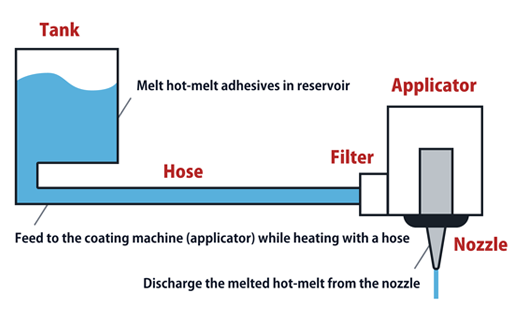What is Hot-melt? Environmentally friendly adhesives

As the name "Hot + Melt" suggests, it is solid at room temperature, but when heated it melts and becomes liquid. It is known as an "environmentally friendly adhesives" because it does not use organic solvents and does not require a drying process.
- Definition of hot melts
- Features of hot melts
- Advantages of hot melts
- hot melts coating method
- Examples of hot melts usage
Definition of hot melts
- adhesives that is solid at room temperature and whose main component is a thermoplastic polymer that does not contain any water or organic solvents.
- It solidifies in a short time by applying it after heating and melting it and cooling it.
- multi-component adhesives



hot melts have the following characteristics that make them different from other adhesives.
Features of hot melts
- It becomes liquid when heated and solidifies when left to cool.
- Contains no organic solvents
- Characteristics and uses vary depending on the base polymer, which is the main component.
Main hot melts base polymers and their properties
| Main component | Characteristic | Main applications |
|---|---|---|
| EVA (ethylene vinyl acetate copolymer) system | Because it has good compatibility with tackifiers and waxes, there is a high degree of freedom in designing adhesive properties. Relatively cheap. | Bookbinding, cardboard, packaging, woodworking |
| Olefin type | Good adhesion to PE and PP. Excellent heat resistance. | Packaging, building materials, automobiles |
| Synthetic rubber (elastomer) type | The adhesive layer has elasticity and has excellent adhesion to paper, nonwoven fabrics, and films. | sanitary materials, packaging |
| Reactive polyurethane (PUR) system | Reactive hot melts hardens by reacting with humidity and moisture. It has high heat resistance because it does not remelt due to heat. It also has excellent flexibility. | building materials, automobiles, bookbinding |
| polyamide type | Excellent heat resistance, chemical resistance, and electrical insulation. | Electrical and electronic parts, automobiles |
| Polyester-based | Can be bonded to a wide range of materials. Excellent thermal stability and durability. | Electrical and electronic parts, automobiles |
When using hot melts, there are the following advantages and precautions.
Advantages of hot melts
Improved productivity
- No drying equipment required, saving energy and space
- Faster adhesion speeds up work
- Easy to automate the bonding process
Easy to handle
- Contains no organic solvents, so there is little risk of poisoning or fire
- No need to treat wastewater or waste liquid
- Since it is not a dangerous item, there are few regulations when storing and transporting it.
- Since it is solid at room temperature, it can be efficiently stored and transported.
Can be bonded to a wide range of materials, with various application patterns available
- Can be bonded not only to paper and metal but also to difficult-to-bond substrates (PP/PE)
- A variety of coating patterns are possible, including dots, spirals, and roll coats.
Precautions for use
- Care must be taken to avoid burns as it is used at high temperatures.
- Easy to deteriorate due to long-term heating
- Requires special applicator (coating machine)
hot melts coating method
To apply hot melts, we use a special "hot melts applicator (coating machine)" that comes with a tank, hose, nozzle, etc. as shown in the illustration below.

Examples of hot melts usage

food packaging material

cardboard

Bookbinding

diapers/sanitary

Clear case

Solar cells backseat

Automobile mat

straw attachment

PET bottle body label
We have a wide lineup of hot melts products for a variety of uses. We also carry out improvements and developments according to customer requests, so please feel free to contact us.
Inquiries
TOYOCHEM CO., LTD. Packaging and Industrial Materials Sales Division Address Sales Department
TEL: +81-3-3272-3497
